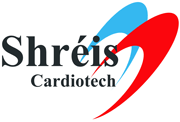|
Frequently
asked Questions
What
is Realistic Geometry Cartographic Imaging?
The
new field of Realistic Geometry Cartographic Imaging (RGCI) finds
application in the field of Science, Technology, Oil Exploration, Nuclear
Science, Medical Imaging etc,. RGCI is a patent pending imaging technique,
where, in simple terms, the structure of an object is imaged based on the
behavior of the object.
How
is RGCI applied in Imaging Coronary Artery Stenosis?
The
parameters needed for RGCI are first acquired. The acquired parameters are
then mapped against a mathematical model and a cartogram is obtained, which
is the collective behavioral pattern of the Heart and its Circulation
status. The deviation difference of these behavioral patterns are then
calculated and a three dimensional array of image units are created which is
embedded in to a realistic geometry model of the structure of the
coronaries. These images are called Realistic Geometry
Cartographic Images (RGCI)..
What
are the parameters needed for RGC Imaging of Coronary Artery Disease. ?
Since
the Human Cardiovascular system is a closed loop fluid mechanics system, we
will need all the parameters relating to Pressure, Volume and Time to obtain
the true behavior of the system.
How
are such complex parameters obtained non-invasively?
All
these complex parameters are obtained using high precision data acquisition
system. Pressure, Volume, Time are collectively obtained by simultaneously
recorded Electrocardiography, Vertical acceleration detection (VAD) of heart
sounds, non-invasive continuous
blood pressure, trans-aortic signal wave modulation (TASWM) and Turbulent
Flow Accelerometry (TFA).
How
are the measurement made on the patients?
The
patient is first wired to the Haemoseis using 12
disposable electrode (4 for ECG and 8 for TASWM and
a special high sensitive narrow bandwidth VAD. The recording is
made for about 5 minutes at rest in the supine position. A high-speed computer
with parallel processing architecture computes the algorithms and prints out
the results.
How
long does the whole procedure take?
The
whole procedure takes about 20 minutes, from start to finish.
What
do I get as a result?
You
get the data that was never possible earlier by non-invasive methods.
You get the complete cardiac haemodynamics including beat-to-beat stroke
volume, all systolic and diastolic time intervals, pressure, volume and Time
relationship, relative myocardial oxygen demand, supply and coronary
reserve, diastolic filling patterns, preload, afterload, contractility and
left ventricular ejection rate. All these parameters give the patient's
complete cardiac status.
What
about the Images ?
Images
include the cardiovascular cartography, which signifies the pressure, volume
and time relationship. The realistic geometry view of the coronaries,
that indicate the location and severity of coronary artery disease and the
relative myocardial oxygen demand, supply and reserve curves.
How
accurate is the RGC imaging when compared to coronary angiography studies ?
The
last reported study shows that RGC imaging has a positive predictive
accuracy of 98.28% and a negative predictive accuracy of 82.16% in detecting
coronary artery disease. And a sensitivity and specificity of over 90%,
which the experts say is good enough for a non-invasive test.
Up
to what level of coronary artery disease can the RGC imaging detect?
RGC
Imaging can detect coronary artery stenosis as low as 20 %. Theoretically,
RGC Imaging should also detect elastic stenosis that is vulnerable and
cannot be seen on coronary angiograms.
What
are the other uses of RGC Imaging in my clinical practice?
In
cardiology, well! This is the only way to follow neonates during intensive
treatment, where invasive techniques are impossible. You can determine the
haemodynamic state of your patient when invasive methods cannot be utilized.
Trend analysis will help you in determining the proper therapy with the use
of selected parameters. You can forecast myocardial ischemia, prior to
development of anginal pain. You can optimize AV delay in patients with dual
chamber pacemakers and impaired left ventricular function. You can use it
during rehabilitation of your post-CABG and post-PTCA patients by
determining the actual working point of the heart related to flow and
pressure by each measurement, besides reliably detecting Coronary artery
disease.
Has
any part of this technique made it to a scientific podium?
Yes.
At the 8th European congress of intensive care medicine, Athens,
Greece, 1995, 12th International congress " The new
Frontiers of Arrhythmias", Italy, 1996. 3rd International
conference on Impedance Cardiography, Domdovar, Hungary, 1997. The 4th
Asia pacific symposium on electrophysiology, New Delhi, India, 1997. The 50th
scientific session of the cardiological society of India, Mumbai, India,
1998.
IEEE conference on Computers in Medicine, NIH, Bethesda, MD, USA in July
2001, to name a few.
Is
the RGC Imaging used anywhere ?
The
technique is being studied in many parts of Europe and in India there are
quite a few Installations that have just started providing RGC imaging
services.
The system is now being introduced into the United
States, Canada, Mexico and South American countries by Shréis-Cardiotech Inc.
Is
there any skepticism about RGC Imaging ?
Yes,
there is bound to be skepticism as is normal in any filed of activity.
This is but natural, mainly due to not looking at the system with an
open mind. A trained physician is needed to interpret the results and
"cardiovascular mapping" requires a physician who is
specially trained to analysis these maps. Errors can creep in only in
the interpretation. RGC of thousands of patients studied and the
results agreed very well with their coronary angiograms.
What
is cardiovascular mapping?
Cardiovascular
mapping was the first step into physiology based diagnosis of coronary
artery disease. It was the first generation non-invasive method to determine
coronary artery disease, based on cardiac haemodynamic variability. Though
the cardiovascular mapping was highly accurate, it needed a trained
physician to interpret the map patterns. RGC imaging is straight forward,
and does not require a trained physician but a physician familiar with
coronary anatomy can interpret the images.
How
expensive is the complete system ?
The
complete system 'HaemoSeis - 256' including the software is extremely low cost
compared to some of the systems available in the research and medical field
that provide only a fraction of the output that HaemoSeis - 256 gives.
How
expensive it is to conduct one procedure?
This
is where RGC Imaging scores over the other imaging techniques. The cost per
procedure is a fraction of the cost for any other cardiac evaluation.
How
do I check if this technique works. ?
It is very simple, Have the test done on some of your patients who are
scheduled for coronary angiography (better with intra vascular ultra-sound),
check your angiographic findings with the RGC images. Is
this not an Acid Test. ?
Copyright
© Shréis-Cardiotech Inc. 2003 All rights Reserved.
Shréis-Cardiotech Inc is a registered US
Company
|

